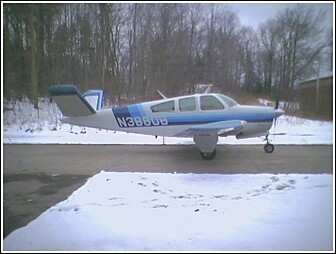Aircraft Was Directed To Land At An Airport That Had Been Closed For 25 Years In 2015, Pilot Fatally Injured
The fatal injury of a pilot who had been directed to land at an airport that had been closed for 25 years in New York State has led to changes in the way the FAA reviews and reports radar video maps.

The passenger on board the airplane survived the accident.
According to the NTSB's probable cause report, the pilot, Joseph Milo, was conducting an on-demand air taxi flight flying a 1952 Beech C35 Bonanza airplane. The passenger reported that, while they were in cruise flight (about 6,500 ft mean sea level, according to radar data), he heard a loud "pop" sound and saw a flicker of light from the engine area, followed by an "oil smell." The engine then began to "sputter" and lost power. The pilot attempted to restart the engine without success. The pilot reported the problem to air traffic control (ATC); however, he did not declare an emergency.
The New York terminal radar approach control (N90) LaGuardia Airport (LGA) departure controller subsequently provided the pilot with the relative locations of several nearby airports, and the pilot determined that he was closest to Republic Airport (FRG), Farmingdale, New York, but that he did not have sufficient altitude to reach it. The LGA controller then provided vectors to Bethpage Airport, an alternate airport depicted on his radar video map (RVM), and noted that, although the airport was closed, there was a runway there. The controller provided vectors to Bethpage for a forced landing, but the pilot reported that he did not see the runway. The next several transmissions between the controller and the pilot revealed that the pilot was unable to acquire the Bethpage runway (because it no longer existed) while the controller continued to provide heading and distance to it. The controller subsequently lost radar contact with the pilot, and the airplane eventually crashed into a railroad grade
crossing cantilever arm before coming to rest on railroad tracks.
The investigation revealed that the runway the controller was directing the pilot to no longer existed; industrial buildings occupied the location of the former airport and had been there for several years. However, the runway was depicted on the controller's RVM because it had not been removed following the closure of the airport. If the RVM had not shown Bethpage as an airport, the controller might have provided alternative diversion options, including nearby parkways, to the pilot, which would have prevented him from focusing on a runway that did not exist. Further investigation revealed that the FAA did not require periodic review and validation of RVMs and had no procedures to ensure that nonoperational airports were removed from RVMs systemwide.

Since this accident, the FAA has revised and corrected its internal procedures to ensure all nonoperational airports are removed from RVMs in the United States.
A toxicology report indicates there were several drugs in the pilot's system, including some that are used to treat panic disorders and seizures. The NTSB said that it is likely the pilot was abusing the substances, and the combination of the pilot's use of drugs and his medical conditions likely significantly impaired his psychomotor functioning and decision-making and led to his delay in responding appropriately to the in-flight loss of engine power and, therefore, contributed to the accident. Review of radar data revealed that 2 minutes 18 seconds had elapsed and that the airplane had lost about 2,000 ft of altitude while continuing on a westerly heading before the pilot turned the airplane toward FRG. If the pilot had turned immediately after he realized the engine had lost power, he would have had adequate altitude to glide to a suitable runway.
The NTSB concluded that the probable cause(s) of this accident were the pilot's improper decision to delay turning toward a suitable runway once he realized that an engine failure had occurred, which resulted in his having inadequate altitude to glide to a suitable runway, and the New York terminal radar approach control LaGuardia Airport area controller's provision of erroneous emergency divert airport information to the pilot.
Contributing to the accident were (1) the Federal Aviation Administration's lack of a requirement to periodically review and validate radar video maps, (2) the failure of the engine crankshaft due to a bearing shift, and (3) the pilot's impairment due to his abuse of amphetamine and underlying medical condition(s).
(Source: NTSB. Image from file. Not accident aircraft)
 Classic Aero-TV: Remembering Bob Hoover
Classic Aero-TV: Remembering Bob Hoover ANN FAQ: Follow Us On Instagram!
ANN FAQ: Follow Us On Instagram! ANN's Daily Aero-Linx (05.15.24)
ANN's Daily Aero-Linx (05.15.24) ANN's Daily Aero-Term (05.15.24):Altimeter Setting
ANN's Daily Aero-Term (05.15.24):Altimeter Setting Aero-News: Quote of the Day (05.16.24)
Aero-News: Quote of the Day (05.16.24)




